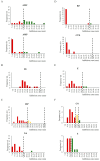Widespread Multidrug Resistance of Arcobacter butzleri Isolated from Clinical and Food Sources in Central Italy
- PMID: 37627712
- PMCID: PMC10451661
- DOI: 10.3390/antibiotics12081292
Widespread Multidrug Resistance of Arcobacter butzleri Isolated from Clinical and Food Sources in Central Italy
Abstract
The Arcobacter genus comprises a group of bacteria widely distributed in different habitats that can be spread throughout the food chain. Fluoroquinolones and aminoglycosides represent the most common antimicrobial agents used for the treatment of Arcobacter infections. However, the increasing trend of the antimicrobial resistance of this pathogen leads to treatment failures. Moreover, the test implementation and interpretation are hindered by the lack of reference protocols and standard interpretive criteria. The purpose of our study was to assess the antibiotic resistance pattern of 17 A. butzleri strains isolated in Central Italy from fresh vegetables, sushi, chicken breast, and clinical human samples to provide new and updated information about the antimicrobial resistance epidemiology of this species. Antimicrobial susceptibility testing was carried out by the European Committee on Antimicrobial Susceptibility Testing (EUCAST)'s disc diffusion method. All the strains were multidrug resistant, with 100% resistance to tetracyclines and cefotaxime (third generation cephalosporins). Some differences were noticed among the strains, according to the isolation source (clinical isolates, food of animal origin, or fresh vegetables), with a higher sensitivity to streptomycin detected only in the strains isolated from fresh vegetables. Our data, together with other epidemiological information at the national or European Union (EU) level, may contribute to developing homogeneous breakpoints. However, the high prevalence of resistance to a wide range of antimicrobial classes makes this microorganism a threat to human health and suggests that its monitoring should be considered by authorities designated for food safety.
Keywords: Arcobacter butzleri; chicken breast; disc diffusion method; fresh vegetables; human arcobacteriosis; multidrug resistance (MDR); sushi.
Conflict of interest statement
The authors declare no conflict of interest.
Figures



References
-
- Ferreira S., Oleastro M., Domingues F. Current insights on Arcobacter butzleri in food chain. Curr. Opin. Food Sci. 2019;26:9–17. doi: 10.1016/j.cofs.2019.02.013. - DOI
-
- Callbeck C.M., Pelzer C., Lavik G., Ferdelman T.G., Graf J.S., Vekeman B., Schunck H., Littmann S., Fuchs B.M., Hach P.F., et al. Arcobacter peruensis sp. nov., a Chemolithoheterotroph Isolated from Sulfide- and Organic-Rich Coastal Waters off Peru. Appl. Environ. Microbiol. 2019;85:e01344-19. doi: 10.1128/AEM.01344-19. - DOI - PMC - PubMed
Grants and funding
LinkOut - more resources
Full Text Sources
Molecular Biology Databases

